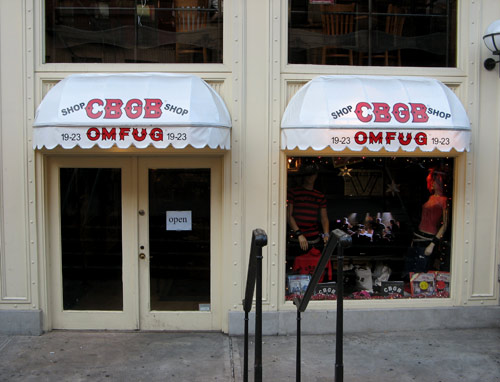Day: January 7th, 2007
Arts & Leisure Sunday
On St. Mark’s Place on a sunny Sunday:
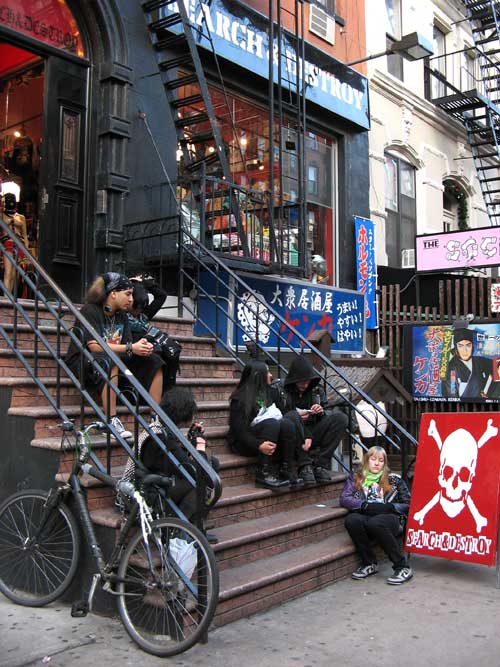
And down the block, the CBGB-OMFUG Shop opened at last, lest we forget that the club was once a relevant rock-institution on the Bowery. And if you’re looking to own a piece of rock n’ roll history — yes, an actual 12′ x 13′ piece — you can find it on eBay(!) But hurry: bidding closes at 19:26:49 PST on January 17.
Dozens of cyclists paid tribute to the 14 cyclists killed by motorists in 2006, visiting each of the accident sites in a citywide ride organized by pro-cycling groups Time’s Up and Transportation Alternatives.
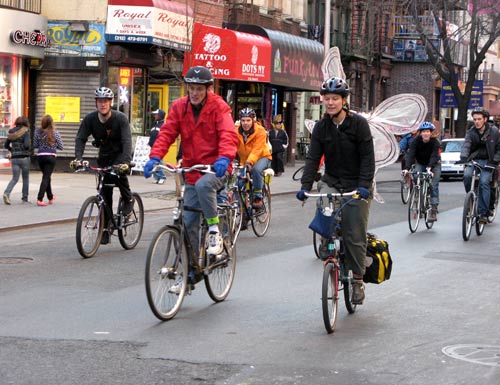

Since I had missed out on this month’s installment of Suzan-Lori Parks 365 Days/365 Plays, my schedule was clear to attend the New York Times Arts & Leisure weekend screenings. Today’s would be held at the ImaginAsian Theater, in a space that once housed a single-screen arthouse theater that was part of a complex of smaller theaters, all located within a couple of blocks of each other. The theater closed in 2003, reopening in the summer of 2004 as a venue for showcasing Asian and Asian-American films, hosting film festivals (including the New York Asian Film Festival), special events and exhibitions.
By the time I arrived in midtown for the Little Miss Sunshine screening, the ticketholders line had stretched East to the entrance of the Queensboro Bridge, an optimal (if chilly) vantage point for the Roosevelt Island trams, making their 4.5 minute rides over the East River.
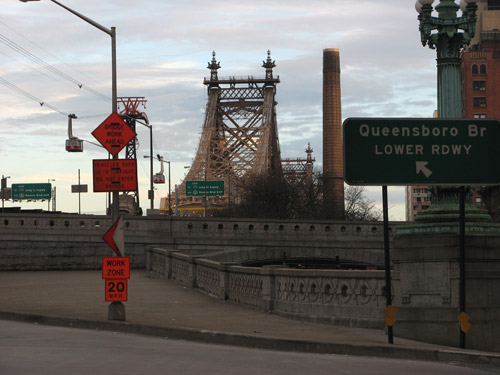
Marc Turtletaub, Peter Saraf and Jeb Brody bought the script to Little Miss Sunshine from first-time screenwriter Michael Arndt for $250,000. Focus Features picked up the film rights, but after stalling production in 2004, the producers bought back the rights from the studio in 2005, opting to cover the entire budget themselves, despite not knowing how commercially viable the unconventional story would be. First timers Jonathan Dayton and Valerie Faris, then best known for creating The Smashing Pumpkins “1979“ music video, directed. The rest, of course, is independent film history: in January 2006, Little Miss Sunshine debuted to critical acclaim at Sundance. After a frenzied bidding war, Fox Searchlight acquired the worldwide rights for more than $10 million — the record set by Miramax’s purchase of Happy, Texas in 1999.
Sometimes the anticipation I have for a film builds to the point that I’m ultimately disappointed (see: Children of Men), but I loved Little Miss Sunshine, which managed to be hilarious, bizarre and touching all at once. I’d had only the broadest notion of the plot going in — knowing it had something to do with a family road trip and a beauty pageant, and nothing at all with the children’s books character created by Roger Hargreaves — so at the climax when the film could have veered easily and dangerously into tritely awful territory, I was pleasantly surprised.
Producers Peter Saraf and Jeb Brody were on hand to discuss the film afterwards, offering some insight into the filming. Apparently, the casting of Steve Carell as the suicidal, gay Proustian scholar uncle was something of a point of contention; NBC had aired just a few episodes of its midseason replacement, The Office, and The 40-Year-Old Virgin had not yet introduced Carell’s hirsute torso to cinemagoers everywhere. In the span of just one year, though, Carell’s star had risen such that the producers went from initially protesting his casting to tapping him to do prominent promotion for the film.
I was most interested to learn that although some have seen the film as a satire or veiled criticism of child beauty pageants, all of the young girls acting as participants in the eponymous contest, except for star Abigail Breslin, were cast from real-life beauty pageants. For the film, the elaborately coiffed little misses merely recycled their own actual outfits and talent performances — no exaggeration necessary. Yikes.
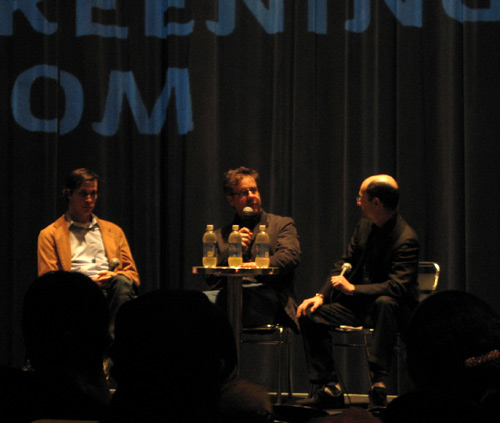
After meeting CS for a non-pizza dinner at Patsy’s, we headed back to the ImaginAsian for a screening of Freedom Writers — not Freedom Riders, though the protagonists do draw some inspiration from the Civil Rights-era demonstrators. The film, of course, is based on a true and familiar story: think To Swank, With Love; Swank and Deliver; Dangerous Minds 2 — Electric Boogaloo. Despite some unfortunate caricatures (evil department heads, rival teachers), the film wisely manages to keep the saccharine-levels in check most of the time, and Swank is effectively charismatic in her portrayal of the inspiring Erin Gruwell, alternating as needed between cock-eyed optimism and steely determination.
Search
Popular Tags
Categories
Archive
- July 2010
- July 2009
- January 2009
- November 2008
- September 2008
- August 2008
- July 2008
- June 2008
- May 2008
- April 2008
- March 2008
- February 2008
- January 2008
- December 2007
- November 2007
- October 2007
- September 2007
- August 2007
- July 2007
- June 2007
- May 2007
- April 2007
- March 2007
- February 2007
- January 2007
- December 2006
- November 2006
- October 2006
- September 2006
- August 2006
- July 2006
- June 2006
